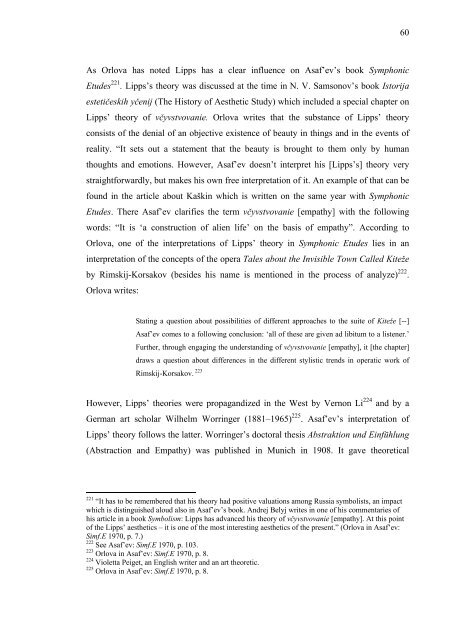Boris Asaf'ev and the Soviet Musicology - E-thesis
Boris Asaf'ev and the Soviet Musicology - E-thesis
Boris Asaf'ev and the Soviet Musicology - E-thesis
You also want an ePaper? Increase the reach of your titles
YUMPU automatically turns print PDFs into web optimized ePapers that Google loves.
As Orlova has noted Lipps has a clear influence on Asaf’ev’s book Symphonic<br />
Etudes 221 . Lipps’s <strong>the</strong>ory was discussed at <strong>the</strong> time in N. V. Samsonov’s book Istorija<br />
estetičeskih yčenij (The History of Aes<strong>the</strong>tic Study) which included a special chapter on<br />
Lipps’ <strong>the</strong>ory of včyvstvovanie. Orlova writes that <strong>the</strong> substance of Lipps’ <strong>the</strong>ory<br />
consists of <strong>the</strong> denial of an objective existence of beauty in things <strong>and</strong> in <strong>the</strong> events of<br />
reality. “It sets out a statement that <strong>the</strong> beauty is brought to <strong>the</strong>m only by human<br />
thoughts <strong>and</strong> emotions. However, Asaf’ev doesn’t interpret his [Lipps’s] <strong>the</strong>ory very<br />
straightforwardly, but makes his own free interpretation of it. An example of that can be<br />
found in <strong>the</strong> article about Kaškin which is written on <strong>the</strong> same year with Symphonic<br />
Etudes. There Asaf’ev clarifies <strong>the</strong> term včyvstvovanie [empathy] with <strong>the</strong> following<br />
words: “It is ‘a construction of alien life’ on <strong>the</strong> basis of empathy”. According to<br />
Orlova, one of <strong>the</strong> interpretations of Lipps’ <strong>the</strong>ory in Symphonic Etudes lies in an<br />
interpretation of <strong>the</strong> concepts of <strong>the</strong> opera Tales about <strong>the</strong> Invisible Town Called Kiteže<br />
by Rimskij-Korsakov (besides his name is mentioned in <strong>the</strong> process of analyze) 222 .<br />
Orlova writes:<br />
Stating a question about possibilities of different approaches to <strong>the</strong> suite of Kiteže [--]<br />
Asaf’ev comes to a following conclusion: ‘all of <strong>the</strong>se are given ad libitum to a listener.’<br />
Fur<strong>the</strong>r, through engaging <strong>the</strong> underst<strong>and</strong>ing of včyvstvovanie [empathy], it [<strong>the</strong> chapter]<br />
draws a question about differences in <strong>the</strong> different stylistic trends in operatic work of<br />
Rimskij-Korsakov. 223<br />
However, Lipps’ <strong>the</strong>ories were propag<strong>and</strong>ized in <strong>the</strong> West by Vernon Li 224 <strong>and</strong> by a<br />
German art scholar Wilhelm Worringer (1881–1965) 225 . Asaf’ev’s interpretation of<br />
Lipps’ <strong>the</strong>ory follows <strong>the</strong> latter. Worringer’s doctoral <strong>the</strong>sis Abstraktion und Einfühlung<br />
(Abstraction <strong>and</strong> Empathy) was published in Munich in 1908. It gave <strong>the</strong>oretical<br />
221<br />
“It has to be remembered that his <strong>the</strong>ory had positive valuations among Russia symbolists, an impact<br />
which is distinguished aloud also in Asaf’ev’s book. Andrej Belyj writes in one of his commentaries of<br />
his article in a book Symbolism: Lipps has advanced his <strong>the</strong>ory of včyvstvovanie [empathy]. At this point<br />
of <strong>the</strong> Lipps’ aes<strong>the</strong>tics – it is one of <strong>the</strong> most interesting aes<strong>the</strong>tics of <strong>the</strong> present.” (Orlova in Asaf’ev:<br />
Simf.E 1970, p. 7.)<br />
222<br />
See Asaf’ev: Simf.E 1970, p. 103.<br />
223<br />
Orlova in Asaf’ev: Simf.E 1970, p. 8.<br />
224<br />
Violetta Peiget, an English writer <strong>and</strong> an art <strong>the</strong>oretic.<br />
225<br />
Orlova in Asaf’ev: Simf.E 1970, p. 8.<br />
60

















